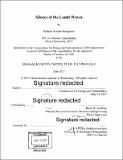| dc.contributor.advisor | Brian W. Anthony. | en_US |
| dc.contributor.author | Benjamin, Rishon Robert | en_US |
| dc.contributor.other | Massachusetts Institute of Technology. Computation for Design and Optimization Program. | en_US |
| dc.date.accessioned | 2017-09-15T15:37:03Z | |
| dc.date.available | 2017-09-15T15:37:03Z | |
| dc.date.copyright | 2017 | en_US |
| dc.date.issued | 2017 | en_US |
| dc.identifier.uri | http://hdl.handle.net/1721.1/111503 | |
| dc.description | Thesis: S.M., Massachusetts Institute of Technology, Computation for Design and Optimization Program, 2017. | en_US |
| dc.description | Cataloged from PDF version of thesis. | en_US |
| dc.description | Includes bibliographical references (pages 101-104). | en_US |
| dc.description.abstract | Roll-to-Roll (R2R) manufacturing has seen great interest in the recent decade due to the proliferation of personalized and wearable devices for monitoring a variety of biometrics. Given the sensitive nature of the potential applications of these sensors, the throughput of manufacturing due to increased demand, and the scale of the electrical components being manufactured, R2R flexible electronics manufacturing technologies require new sensing and measurement capabilities for defect detection and process control. The work presented herein investigates the use of ultrasound, specifically Lamb and longitudinal waves, as a sensing modality and measurement technique for thin film R2R manufacturing substrates. Contact (transducer-based) and non-contact (photoacoustic) generation methods along with deterministic and probabilistic tomographic reconstruction algorithms were implemented evaluate their suitability for non-destructive evaluation (NDE) and in-line control of surface additions of 76[mu]m aluminum and polyethylene terephthalate (PET) films. The ultrasonic waves were used to ascertain properties of these substrates such as the thickness of substrate, applied load, presence of defects (holes/cracks), size of defects, presence of surface features (fluid drops, multi-layer structures), and nature of surface features (differing chemistries). In addition, surface features alter the behavior of sound waves in the presence of such features. These surface features may then be imaged to create tomographic maps. The results presented show that, currently, a quasi-contact acoustic generation scheme can be used to successfully image defects and surface features on the order of -1mm. Furthermore, the algorithm is able to distinguish qualitatively between surface features of differing physiochemical properties. The authors hope that the information collected from this thesis will be part of a rich data set that can contribute to advanced machine-learning frameworks for predictive maintenance, failure, and process control analysis for the R2R process. | en_US |
| dc.description.statementofresponsibility | by Rishon Robert Benjamin. | en_US |
| dc.format.extent | 119 pages | en_US |
| dc.language.iso | eng | en_US |
| dc.publisher | Massachusetts Institute of Technology | en_US |
| dc.rights | MIT theses are protected by copyright. They may be viewed, downloaded, or printed from this source but further reproduction or distribution in any format is prohibited without written permission. | en_US |
| dc.rights.uri | http://dspace.mit.edu/handle/1721.1/7582 | en_US |
| dc.subject | Computation for Design and Optimization Program. | en_US |
| dc.title | Silence of the lamb waves | en_US |
| dc.type | Thesis | en_US |
| dc.description.degree | S.M. | en_US |
| dc.contributor.department | Massachusetts Institute of Technology. Computation for Design and Optimization Program | |
| dc.identifier.oclc | 1003323615 | en_US |
